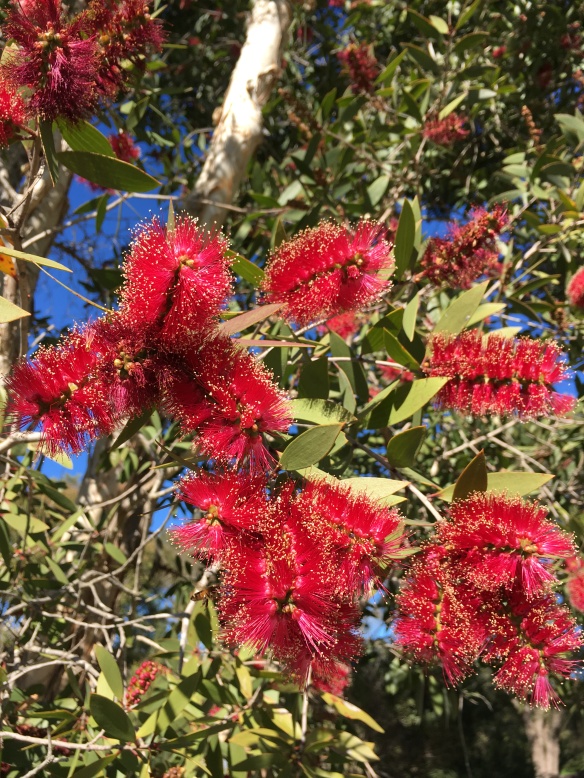As you may have read in my previous blog post (here) I have partnered with the Australian Botanic Gardens, Mount Annan, for my PhD and I am undertaking a big project looking at the effects of climate change on Australian species using seeds collected and stored at the PlantBank which is part of the Botanic Gardens. Today I finished up early on my seed work in the PlantBank and decided that the “winter” weather (it was a sunny 18°C in Sydney today) was far too nice to not be enjoyed and so I went exploring the botanic gardens at Mount Annan that surround the labs at the PlantBank.
I wanted to write this post as a sort of naturalist recount of the surroundings of the Botanic gardens. Two reasons prompted me to do so:
- I attended a talk by the remarkable Dr Jane Goodall on Friday evening and she reminded me of the magic of nature and how important it is to take time to sit and be present in the environment in order to understand how important and intertwined it is to all aspects of our daily lives. After a few busy weeks in the office it was about time for me to get outside and enjoy the beauty of the plants and animals around me, after all, this is what inspired me to embark on a long journey of studying plant ecology!
- Everyone has heard of and visited the Royal Botanic Gardens, Sydney but not many people have seen the Australian Botanic Gardens, Mount Annan. Although it may be a further out of Sydney it is still a great place to go and I would highly recommend a day trip and picnic here, especially if you love gardens.
I have been to many botanic gardens around Australia and the world. I make it a goal of mine to visit the botanic gardens in every city I travel to. My wonderful husband puts up with this and allows us to devote a few hours or so on our holidays to strolling through gardens in various places. The Australian Botanic Garden, Mount Annan is by far the largest garden I have ever been to. You can drive around the outskirts, walk through trails over the rolling hills, bike ride through the lakes and lawns or just take a stroll through the 416 hectares of the gardens.
The Vegetation types
As you walk through the gardens you pass many different vegetation types, a bit of Australian rainforest, rocky arid areas, eucalypt forests and many different native plant species. Click on the circles below for some of the different types of vegetation.



The Plants
They have so many cool native plants here, here’s just a few of them with a bit of information.





The Creatures and Critters
As you’ve already seen, the gardens are filled with native bees that pollinate the vast arrray of native flowers. It’s so peaceful there that you can hear them buzzing as you walk around. Birds also use the huge gardens as habitat. Although I am a terrible bird photographer/watcher I got to sit and eat lunch by the pond with rainbow lorikeets singing in the trees behind me, swallows flitting on the lawn beside me and ducks and cormorants gliding through the pond in front of me. Not a bad spot to have a lunch break!


The Conservation
Not only does the Australian Botanic Garden conserve thousands of species by locking their seeds and tissues safely in freezing vaults in the PlantBank, they also conserve living trees across their widespread gardens. There is a large area of land devoted to conserving the threatened Cumberland Plain Woodland vegetation. This type of community consists of various native plants and is only found in small patches across western Sydney as land clearing has led to it’s decrease.

They also conserve various Australian trees such as banksia, wattles, Eucalypts and Casuarinas in arboreta (collections of trees).
The Art
There are various sculptures hidden around the gardens which you can find if you look closely. I think it’s awesome that the Australian Botanic Gardens have combined nature with art to communicate facts and ideas about the environment in a new and interesting way.



To leave you with something special (and for reading this whole post) – the magic of nature, as usual, did not disappoint. As I was wandering through my favourite part of the garden the daisy (Asteraceae) section. I was quiet and still enough to capture a monarch butterfly (Danaus plexippus) pollinating a Xerochrysum bracteatum flower!

References
https://www.australianbotanicgarden.com.au/
http://www.environment.gov.au/resource/cumberland-plain-woodland






Such a pleasure to read! And great photos. What camera did you use?
LikeLike
Just my iPhone, the sun was working for me that day haha.
LikeLike